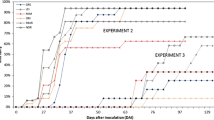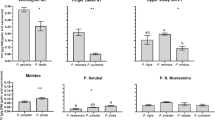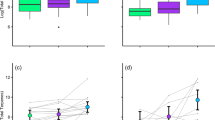Abstract
Key message
Migration ability of the PWN through wood branch tissues of adult Maritime pine trees significantly differed among Iberian provenances and this variation was related to differences in anatomical and chemical defensive traits.
Abstract
The pinewood nematode or pine wilt nematode (PWN; Bursaphelenchus xylophilus) is one of the most dangerous threats to European coniferous forests, especially for the susceptible Maritime pine (Pinus pinaster), a valuable forest resource in South Western Europe. The PWN is vectored by beetles of the genus Monochamus (Coleoptera, Cerambycidae) and once inoculated in healthy branches, it quickly migrates downward to the main trunk through the resin canal system. Therefore, the anatomy of the resin canal system may modulate its migration and proliferation rates. Using material from nine Maritime pine Iberian provenances established in a common garden trial, we investigated whether these provenances differed in their (1) resin canal anatomy, (2) concentration of chemical defences (non-volatile resin and total polyphenolics) in stems and (3) ability of the PWN to migrate through the pine woody tissues in ‘in vitro’ bioassays. Whether variation in anatomical and chemical defensive traits relates to differences in PWN migration across populations was also investigated. Significant intraspecific variation in anatomical and chemical defensive traits and in nematode migration rates through pine tissues was observed. Moreover, the variation in nematode migration rate among pine provenances was related to differences in both anatomical and chemical features. Overall, this study highlights the role of plant genetics in the development of defensive traits against this harmful coniferous pest. The observed intraspecific variation should be taken into account when considering breeding as a strategy to provide areas of high risk of PWN with resistant genetic material.




Similar content being viewed by others
References
Akiba M, Ishihara M, Sahashi N, Nakamura K, Ohira M, Toda T (2012) Virulence of Bursaphelenchus xylophilus isolated from naturally infested pine forests to five resistant families of Pinus thunbergii. Plant Dis 96:249–252
Arrabal C, Cortijo M, Fernández de Simón B, García Vallejo MC, Cadahía E (2005) Differentiation among five Spanish Pinus pinaster provenances based on its oleoresin terpenic composition. Biochem Syst Ecol 33:1007–1016
Bucci G, Gonzalez Martinez SC, Le Provost G et al (2007) Range-wide phylogeography and gene zones in Pinus pinaster Ait. revealed by chloroplast microsatellite markers. Mol Ecol 16:2137–2153
Burban C, Petit RJ (2003) Phylogeography of maritime pine inferred with organelle markers having contrasted inheritance. Mol Ecol 12:1487–1495
Burban C, Petit RJ, Carcreff E, Jactel H (1999) Rangewide variation of the maritime pine bast scale Matsucoccus feytaudi Duc. (Homoptera: matsucoccidae) in relation to the genetic structure of its host. Mol Ecol 8:1593–1602
Butcher TB (2007) Achievements in forest tree genetic improvement in Australia and New Zealand. Maritime pine and Brutian pine tree improvement programs in Western Australia. Aus For 70:141–151
Chambel MR, Climent J, Alía R (2007) Divergence among species and populations of Mediterranean pines in biomass allocation of seedlings grown under two watering regimes. Ann For Sci 64:87–97
Corcuera L, Gil-Pelegrín E, Notivol E (2012) Differences in hydraulic architecture between mesic and xeric Pinus pinaster populations at the seedling stage. Tree Physiol 32:1442–1457
Dayi M, Akbulut S (2012) Pathogenicity testing of four Bursaphelenchus species on conifer seedlings under greenhouse conditions. For Pathol 42:213–219
de la Mata R, Zas R (2010a) Performance of maritime pine Spanish Mediterranean provenances in a transitional region between Atlantic and Mediterranean climates in NW Spain. Silvae Genet 59:8–17
de la Mata R, Zas R (2010b) Transferring Atlantic maritime pine improved material to a region with marked Mediterranean influence in inland NW Spain: a likelihood-based approach on spatially adjusted field data. Eu J For Res 129:645–658
Dwinell LD (1984) Relative susceptibilities of 5 southeastern pine species to the pinewood nematode, Bursaphelenchus xylophilus. Phytopathology 74:870
Eo J, Takemoto S, Otobe K (2011) Is there a relationship between the intrinsic rate of propagation and in vitro migration and virulence of the pinewood nematode, Bursaphelenchus xylophilus? Eu J Plant Pathol 130:231–237
Esteban LG, Martín JA, de Palacios P, García-Fernández F (2012) Influence of region of provenance and climate factors on wood anatomical traits of Pinus nigra Arn. subsp. salzmannii. Eu J For Res 131:633–645
Evans H, Futai K (2008) Ecology and modeling. In: Vieira P, Mota M (eds) Pine wilt disease: a worldwide threat to forest ecosystems. Springer, Germany, pp 255–257
Evans S, Evans H, Ikegami M (2008) Modelling PWN-induced wilt expression: A mechanistic approach. In: Vieira P, Mota M (eds) Pine wilt disease: a worldwide threat to forest ecosystems. Springer, Germany, pp 259–278
Fernandes PM, Rigolot E (2007) The fire ecology and management of maritime pine (Pinus pinaster Ait.). For Ecol Manage 241:1–13
Fernández JM, Solla A (2008) Mapas de riesgo de aparición y desarrollo de la enfermedad del marchitamiento de los pinos (Bursaphelenchus xylophilus) en Extremadura. For Syst 15:141–151
Franco AR, Santos C, Roriz M, Rodrigues R, Lima MRM, Vasconcelos MW (2011) Study of symptoms and gene expression in four Pinus species after pinewood nematode infection. Plant Gen Res 9:272–275
Futai K (2003) Abnormal metabolites in pine wood nematode-inoculated Japanese black pine. Jap J Nematol 33:45–56
Gaspar MJ, Velasco T, Feito I, Alía R, Majada J (2013) Genetic variation of drought tolerance in Pinus pinaster at three hierarchical levels: a comparison of induced osmotic stress and field testing. PLoS One 8(11):e79094
González-Martínez SC, Alía R, Gil L (2002) Population genetic structure in a Mediterranean pine (Pinus pinaster Ait.): a comparison of allozyme markers and quantitative traits. Heredity 89:199–206
Hanawa F, Yamada T, Nakashima T (2001) Phytoalexins from Pinus strobus bark infected with pinewood nematode Bursaphelencus xylophilus. Phytochemistry 57:223–228
Ichihara Y, Fukuda K, Suzuki K (2000a) Early symptom development and histological changes associated with migration of Bursaphelenchus xylophilus in seedling tissues of Pinus thunbergii. Plant Dis 84:675–680
Ichihara Y, Fukuda K, Suzuki K (2000b) The effect of periderm formation in the cortex of Pinus thunbergii on early invasion by the pinewood nematode. For Pathol 30:141–148
Jactel H, Kleinhentz M, Marpeau-Bezard A, Marion-Poll F, Menassieu P, Burban C (1996) Terpene variation in maritime pine constitutive oleoresin related to host tree selection by Dyorictria sylvestrella Ratz. (Lepidoptera, Pyralidae). J Chem Ecol 22:1037–1050
Kawaguchi E (2006) Relationship between the anatomical characteristics of cortical resin canals and migration of Bursaphelenchus xylophilus in stem cuttings of Pinus thunbergii seedlings (in Japanes with English summary). J Jap For Soc 88:240–244
Koricheva J, Nykänen H, Gianoli E (2004) Meta-analysis of trade-offs among plant antiherbivore defenses: are plants jacks-of-all-trades, masters of all? Am Nat 163:E64–E75
Kuroda K (2004) Inhibiting factors of symptom development in several Japanese red pine (Pinus densiflora) families selected as resistant to pine wilt. J For Res 9:217–224
Kuroda K (2008a) Defense systems of Pinus densiflora cultivars selected as resistant to pine wilt disease. In: Vieira P, Mota M (eds) Pine wilt disease: a worldwide threat to forest ecosystems. Springer, Germany, pp 313–320
Kuroda K (2008b) Physiological incidences related to symptom development and wilting mechanism. In: Zhao B, Futai K, Sutherland JR, Takeuchi Y (eds) Pine wilt disease. Springer, Japan, pp 204–222
Kuroda K, Yamada T, Ito S (1991) Bursaphelenchus xylophilus induced pine wilt: factors associated with resistance. Eu J For Pathol 21:430–438
Kuroda H, Goto S, Kazumi E, Kuroda K (2011) The expressed genes of Japanese red pine (Pinus densiflora) involved in the pine wilt disease severity. BMC Proceedings 5(Suppl. 7):92
Lamy J-B, Lagane F, Plomion C, Cochard H, Delzon S (2012) Micro-evolutionary patterns of juvenile wood density in a pine species. Plant Ecol 213:1781–1792
Lima M, Ramos M, Sampedro L, Moreira X, Zas R, Vasconcelos M (2012) Teste de susceptibilidade ao nematodo da madeira do pinheiro–optimizaçao para utilizaçao en larga escala. Cuad Soc Esp Cien For 36:21–26
Littell RC, Milliken GA, Stroup WW, Wolfinger RD, Schabenberger O (2006) SAS System for mixed models, 2nd edn. SAS Institute, Cary
Martín JA, Esteban LG, de Palacios P, García-Fernández F (2010) Variation in wood anatomical traits of Pinus sylvestris L. between Spanish regions of provenance. Trees 24:1017–1028
Moreira X, Sampedro L, Solla A, Zas R (2008) Alterations of the resin canal system of Pinus pinaster seedlings after fertilization of a healthy and of a Hylobius abietis attacked stand. Trees 22:771–777
Moreira X, Alfaro RI, King J (2012) Constitutive defenses and damage in Sitka spruce progeny obtained from crosses between white pine weevil resistant and susceptible parents. Forestry 85:87–97
Moreira X, Mooney KA, Rasmann S, Petry WK, Zas R, Sampedro L (2014) Trade-offs between constitutive and induced defences drive geographical and climatic clines in pine chemical defences. Ecol Lett 17:537–546
Mori Y, Miyahara F, Tsutsumi Y, Kondo E (2008) Relationship between resistance to pine wilt disease and the migration of proliferation of pine wood nematodes. Eu J Plant Pathol 122:529–538
Mota MM, Braasch H, Bravo MA, Penas AC, Burgermeister W, Metge K, Sousa E (1999) First report of Bursaphelenchus xylophilus in Portugal and in Europe. Nematology 1:727–734
Nose M, Shiraishi S (2008) Breeding for resistance to pine wilt disease. In: Zhao B, Futai K, Sutherland JR, Takeuchi Y (eds) pine wilt disease. Springer, Japan, pp 334–350
Nunes da Silva M, Lima MRM, Vasconcelos MW (2013) Susceptibility evaluation of Picea abies and Cupressus lusitanica to the pine wood nematode (Bursaphelenchus xylophilus). Plant Pathol 62:1398–1406
Oku H, Shiraishi T, Chikamatsu K (1989) Active defense as a mechanism of resistance in pine against pine wilt disease. Ann Phytopathol Soc Jap 55:603–608
Prada E, Alía R, Climent J, Díaz R (2014) Seasonal cold hardiness in Maritime pine assessed by different methods. Tree Genet Genom 10:698–701
Ribeiro B, Espada M, Vu T, Nobrega F, Mota M, Carrasquinho I (2012) Pine wilt disease: detection of the pinewood nematode (Bursaphelenchus xylophilus) as a tool for a pine breeding programme. For Pathol 42:521–525
Robertson L, Cobacho Arcos S, Escuer M, Santiago Merino R, Esparrago G, Abellera A, Navas A (2011) Incidence of the pinewood nematode Bursaphelenchus xylophilus Steiner and Buhrer, 1934 (Nickle, 1970) in Spain. Nematology 13:755–757
Rodrigues JM (2008) National eradication programme for the pinewood nematode. In: Mota M, Vieira P (eds) Pine wilt disease: a worldwide threat to forest ecosystems. Springer, Germany, pp 5–14
Ruzin SE (1999) Plant microtechnique and microscopy. Oxford University Press, New York
Sampedro L, Moreira X, Llusia J, Peñuelas J, Zas R (2010) Genetics, phosphorus availability, and herbivore-derived induction as sources of phenotypic variation of leaf volatile terpenes in a pine species. J Exp Bot 61:4437–4447
Sampedro L, Moreira X, Zas R (2011) Costs of constitutive and jasmonate-induced pine tree chemical defences emerge only under low nutrient availability. J Ecol 99:818–827
Santos del Blanco L, Climent J, González-Martínez SC, Pannell JR (2012) Genetic differentiation for size at first reproduction through male versus female functions in the widespread Mediterranean tree Pinus pinaster. Ann Bot 110:1449–1460
Solla A, Aguín O, Cubera E, Sampedro L, Mansilla P, Zas R (2011) Survival time analysis of Pinus pinaster inoculated with Armillaria ostoyae: genetic variation and relevance of seed and root traits. Eur J Plant Pathol 130:477–488
Son JA, Komatsu M, Mtsushita N, Hogetsu T (2010) Migration of pine wood nematodes in the tissues of Pinus thunbergii. J For Res 15:186–193
Sousa E, Bravo MA, Pires J, Naves P, Penas AC, Bonifacio L, Mota MM (2001) Bursaphelenchus xylophilus (Nematoda; Aphelenchoididae) associated with Monochamus galloprovincialis (Coleoptera; Cerambycidae) in Portugal. Nematology 3:89–91
Suga T, Ohta S, Munesada K, Ide N, Kurokawa M, Shimizu M, Ohta E (1993) Endogenous pine wood nematicidal substances in pines, Pinus massoniana P. strobus and P. palustris. Phytochemistry 33:1395–1401
Tadesse W, Auñón FJ, Pardos JA, Gil L, Alía R (2001) Evaluación precoz de la producción de miera en Pinus pinaster Ait. Inv Agr Sist Rec For 10:141–150
Toda T, Kurinobu S (2002) Realized genetic gains observed in progeny tolerance of selected Red pine (Pinus densiflora) and Black pine (P. thunbergii) to pine wilt disease. Silvae Genet 51:42–44
Vicente C, Espada M, Vieira P, Mota M (2012) Pine Wilt Disease: a threat to European forestry. Eu J Plant Pathol 133:89–99
Vivas M, Zas R, Solla A (2012) Screening of Maritime pine (Pinus pinaster) for resistance to Fusarium circinatum, the causal agent of Pitch Canker disease. Forestry 85:185–192
Webster J, Mota M (2008) Pine wilt disease: global issues, trade and economic Impact. In: Mota M, Vieira P (eds) Pine wilt disease: a worldwide threat to forest ecosystems. Springer, pp 1-5
Woo K-S, Lee D-H, Koo Y-B, Yeo J-K (2008) Inoculation of seven pine species or hybrid seedlings with Korean isolates of pinewood nematode under greenhouse conditions. Ann For Sci 65:811
Zas R, Merlo E (2008) El programa de mejora de Pinus pinaster en Galicia. Boletin CIDEU 5–6:5–24
Zas R, Sampedro L, Prada E, Fernández-López J (2005) Genetic variation of Pinus pinaster Ait. seedlings in susceptibility to Hylobius abietis L. Ann For Sci 62:681–688
Zhang F, Kajiwara J, Mori Y, Ohira M, Tsutsumi Y, Kondo E (2013) Metabolites from resistant and susceptible Pinus thunbergii after inoculation with pine wood nematode. Am J Plant Sci 4:512–518
Author contribution statement
LS, RZ and MV conceived the study. LS and XM conducted the sampling and field assessments. XM performed the chemical analyses and the histological analyses with the assistance of LS and AS. MR and ML performed the PWN migration bioassays with the assistance of MNS. RZ performed the statistical analyses, and primarily wrote the manuscript. All authors contributed to the writing and revisions.
Acknowledgments
This study was financed by the Spanish National Research Grants AGL2012-40151 (FENOPIN), co-financed by EU-FEDER, and by the bilateral action Spain-Portugal PRI-AIBPT-2011-1152 (NEMARES). The Portuguese Fundo Florestal Permanente, Instituto de Financiamento da Agricultura e Pescas I.P., Autoridade Florestal Nacional is also acknowledged for funding. We thank Manuel Mota (Universidade de Évora, Portugal) for providing B. xylophilus isolates. The genetic trials in which the samples were collected are part of the experimental set up of the Maritime pine breeding program developed by the Centro de Investigación Forestal de Lourizán, Xunta de Galicia. We thank David Brown for language edition, and Alvin Yanchuk for valuable comments and discussion.
Conflict of interest
The authors declare that they have no conflict of interest.
Author information
Authors and Affiliations
Corresponding author
Additional information
Communicated by J. Penuelas.
Electronic supplementary material
Below is the link to the electronic supplementary material.
Rights and permissions
About this article
Cite this article
Zas, R., Moreira, X., Ramos, M. et al. Intraspecific variation of anatomical and chemical defensive traits in Maritime pine (Pinus pinaster) as factors in susceptibility to the pinewood nematode (Bursaphelenchus xylophilus). Trees 29, 663–673 (2015). https://doi.org/10.1007/s00468-014-1143-6
Received:
Revised:
Accepted:
Published:
Issue Date:
DOI: https://doi.org/10.1007/s00468-014-1143-6




